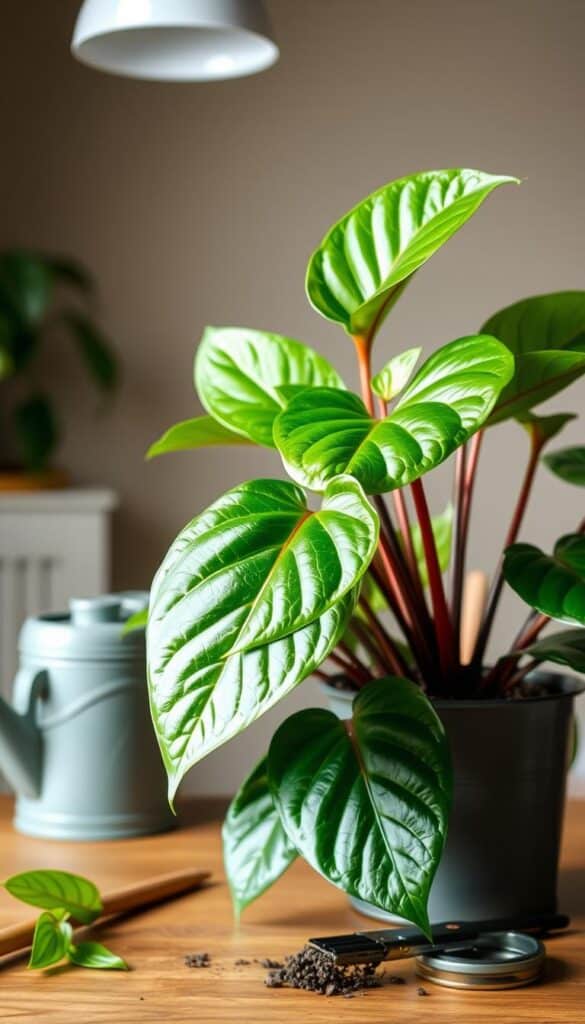Meet the Philodendron Red Emerald, a stunning plant that’s as beautiful as it is beneficial. I still remember the day I brought mine home—its vibrant red and green leaves instantly brightened up my space. But I quickly learned that keeping it thriving wasn’t as straightforward as I thought. That’s why I created this comprehensive guide to help you master the art of nurturing your Philodendron Red Emerald.
Inside this guide, you’ll discover simple yet effective tips on watering, lighting, and potting. Whether you’re a seasoned plant parent or just starting out, you’ll find everything you need to keep your plant healthy and flourishing. From choosing the right soil to propagation techniques, I’ve covered it all to ensure your Red Emerald stays as vibrant as the day you brought it home.
With insights gathered from trusted sources and real-world experience, this guide is your go-to resource for maintaining lush, thriving foliage. Let’s dive in and explore how easy it can be to give your Philodendron Red Emerald the care it deserves.
Getting Started with Your Philodendron Red Emerald
Starting your journey with this beautiful plant begins with the basics. The right pot, soil, and environment are crucial for its growth.
Choosing the Ideal Pot and Soil Mix
Selecting the right pot is essential. Opt for one that is 1-2 inches larger than the plant’s current size to allow room for growth. Ensure the pot has drainage holes to prevent waterlogging, which can lead to root rot.
The soil mix should be well-draining. A mix enriched with perlite or coco coir improves drainage and aeration, promoting healthy root development. Avoid heavy potting soils that can retain too much water.
Setting Up the Perfect Placement Environment
Place your pot plant in a spot with bright, indirect light. Direct sunlight can scorch the leaves, while too little light may slow growth. Aim for a temperature range of 65-75°F (18-24°C) to keep your plant comfortable.
Monitor soil moisture by checking the top inch of soil. Water when it feels dry to the touch. Consistent potting practices help maintain the right soil moisture levels for optimal health.
philodendron red emerald care guide: Water, Light, and Nutrient Essentials
Proper watering, lighting, and humidity are key to keeping your plant thriving. Let’s break down the essentials to ensure your plant stays healthy and vibrant.
Smart Watering and Humidity Management
Watering is one of the most critical aspects of plant care. Aim to water your plant with about 0.5 cups of water every 7-10 days. Adjust this schedule based on your environment—drier spaces may need more frequent watering, while humid areas might require less. Use a moisture meter to check the soil weekly, ensuring it’s moist but not waterlogged. Overwatering can lead to root rot, so it’s better to err on the side of caution.
Optimal Lighting Conditions and Sunlight Tips
Place your plant in bright, indirect light to preserve its vibrant hues. Direct sunlight can scorch the leaves, so position it near a south-facing window but out of direct rays. Maintain a consistent temperature between 65-75°F (18-24°C) for optimal health. Avoid low-light areas, as this can slow growth and dull the leaves.
| Factor | Recommendation |
|---|---|
| Watering Frequency | Every 7-10 days |
| Lighting | Bright, indirect light |
| Humidity | Maintain 40-60% humidity |
| Temperature | 65-75°F (18-24°C) |

By following these guidelines, you’ll create an ideal environment for your plant to flourish. Adjust your care routine based on seasonal changes and monitor your plant’s response to ensure it stays healthy and thriving.
Troubleshooting, Propagation, and Ongoing Maintenance
Maintaining a healthy plant involves more than just watering and sunlight—it’s about catching issues early and giving it the right tools to thrive. Let’s explore how to tackle common problems and keep your plant in top shape.
Identifying and Resolving Common Care Issues
Yellowing leaves or drooping stems often signal overwatering. To prevent root rot, reduce watering and inspect the soil. Improve drainage by adding perlite or adjusting your soil mix.
Propagation Techniques and Pruning Practices
Propagate by taking cuttings, letting them callus, then rooting them. Prune diseased or overgrown stems to encourage bushy growth. Use slow-release fertilizer during the growing season for steady development.
- Check for root rot signs and adjust watering.
- Inspect soil drainage and amend with perlite if needed.
- Prune long stems to promote a fuller plant.
- Repot when roots outgrow the container.
By following these tips, you’ll keep your plant flourishing and prevent common issues. Remember, every plant is unique, so tailor your care routine to its needs.
Final Thoughts on Nurturing Your Indoor Red Emerald Philodendron
As I reflect on my journey with the Red Emerald Philodendron, I’m reminded of how rewarding it is to nurture such a beautiful plant. Over time, I’ve learned that consistent care and attention to detail make all the difference. Regular watering, timely pruning, and the right potting mix have helped my plant maintain strong stems and vibrant leaves.
Monthly check-ins are a great way to catch early signs of stress. Ensuring your plant is in an area with good air circulation and proper drainage can prevent many common issues. Observing how the leaves change color helps me respond to its needs, whether it’s adjusting the lighting or watering schedule.
Every plant is unique, so it’s important to find the right way to care for your Emerald Philodendron. Experiment with different techniques and personalize your routine. Remember, consistency is key to keeping your indoor Red Emerald Philodendron thriving. With patience and the right approach, you’ll enjoy the beauty of your plant for years to come.
